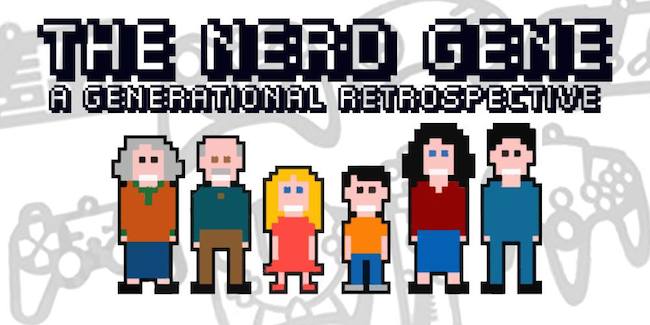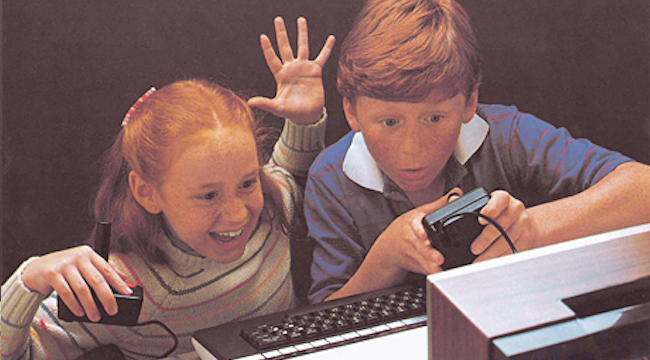
Like everything, gaming has changed with time, and with each new generation. Why, back in my day we had to walk 5 kilometers in the snow, just to get to the arcade! Okay, that’s an exaggeration, but the evolution and progress of the entire gaming culture is a fact. As part of a generation raised on video game consoles, I have my own perception on today’s scene. However, as both the mother and daughter of “gamers,” I can appreciate the innovations for each of our generations. Admittedly, I sometimes still get lost between the 8-bit arcade and the “next generation,” leaving me with middle-child syndrome; “no one understands me!” And yet, gaming is unique in that it remains all-encompassing and brings the player along for the journey, instead of simply outgrowing them.

As a “noob” in the ’90s, a console was the be all and end all; Tamagotchi’s notwithstanding. While I may barely remember my time on the Atari, I can’t forget the thumb-cramping hours spent on the SNES and 64. With four siblings, I was never short of a player two, even though being second youngest meant I was always Luigi; the pixelated effigy of younger siblings worldwide. In the early days, trying to find female friends who enjoyed games was a struggle made more difficult by parents who kept forcing us outside for fear our eyes would go square. The older I got, the more of a staple consoles became in every household, which in turn, started a notable shift in our generation: those that became uninterested entirely, and those who came to prize their games above all else.
PC games were so simple back then, or at least until CERN graced us with the internet. As a result, ’90s gaming quickly became about mastering the art of patience, as in my case, connecting to the net meant eating a bowl of cereal and a chapter of Goosebumps while I waited. As online games burst forth, my Dad introduced me to Quake, Myst and Tomb Raider, and in doing so, birthed a new tradition at the same time. The games weren’t age appropriate for me to play, in retrospect, but I’d still sit up past bedtime on a rickety stool and watch him play as the generation gap slowly became visible to me. It’d take all my willpower not to lean over and take control of the game for him as I found I was grasping game mechanics and making connections for next moves almost naturally, and in saying that, watching my Dad accidently murder Lara over and over could be so frustrating (sorry, Dad).

The way I thought back then was adaptive, and relied on reflexes and instinct for a games mechanics; in much the same way as kids today can operate Apple products in their sleep. Parents would rarely have the inclination or interest to play games, and tried to prevent us kids becoming pale and friendless from too much screen time. I can only assume that gaming was to our parents what the entire decade of the ’60s was to their parents: flippant, a waste of time, and scarily hard to understand. The offspring of our generation are fortunate that we are more understanding and know the importance of waiting for a save point; a lesson hard learned by all of us already.
Today, gaming is a booming entertainment industry whose biggest clientele are us: the 30ish year olds who go way back to when 8-bit graphics were impressive. We, the target audience, have disposable incomes, fast internet, and our own houses which are perfectly suited to displaying all our nerdy collectables. This interactive love affair hasn’t stopped with us, though, and I don’t mean the 14 year olds that dominate MMOs with their swears and mum’s permission- I’m referring to the spawn of gamers. I mean “children.” I can’t find a DVD in my house until I shuffle several consoles and an unholy amount of Skylanders and Infinity characters out of the way. And even though my Son’s game collection is smaller than average, if you add the individual cost of every figure, plus each game being at least $70, and then the game merchandise; you have a GFC: “Gamer’s Financial Crisis.”

Developers specifically target children with games that are no longer “Nintendo hard”, but instead, have tutorials, aids and hints. Currently, they have it easier for several reasons, not least of all the ability to Google walkthroughs if they get stuck. Playing games is now a more acceptable interest, and is age appropriate fun; plus the sheer mass of produced titles means availability and choice will never be an issue for this generation. As a parent, having a shared passion with your child is a wonderful thing, and being able to spend time doing something you both love kicks the old family board game night out the window. If you keep up with scientific publications, you’ll have likely seen recent reports on ways in which gaming is good for us, as well as children, in particular ways. That’s all well and super, but as a mum who watched her son struggle with shoelaces, it’s a pretty proud moment to watch the ease and deftness with which he exercises his imagination in creator-mode. Being a geek also offers a social crutch to kids; it’s easy to find a friend with something in common, and our trips to various conventions provide the “next generation” with the comfort of knowing we are a massive community with common interests.
There will always be peers, and likely many of our parents, still rolling their eyes disapprovingly at adults “playing games,” but in truth, that minority is shrinking. In the meantime, I’m just happy to hear my “noob” tell me how awesome his grandpa was against “The Covenant,” or seeing him and my giant nerd of a boyfriend finally finish Portal 2 together. The way we play has come a long way and is still changing, but progress has managed to not leave many behind. I don’t think of it as a “gap” anymore- really, it’s just an evolution, an upgrade to a new way to play and connect. Now we just do it with better graphics and no 10km hikes, uphill, in the snow, to the arcade.











